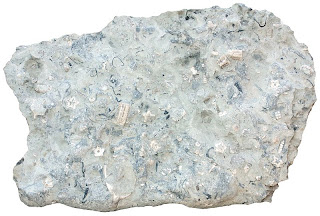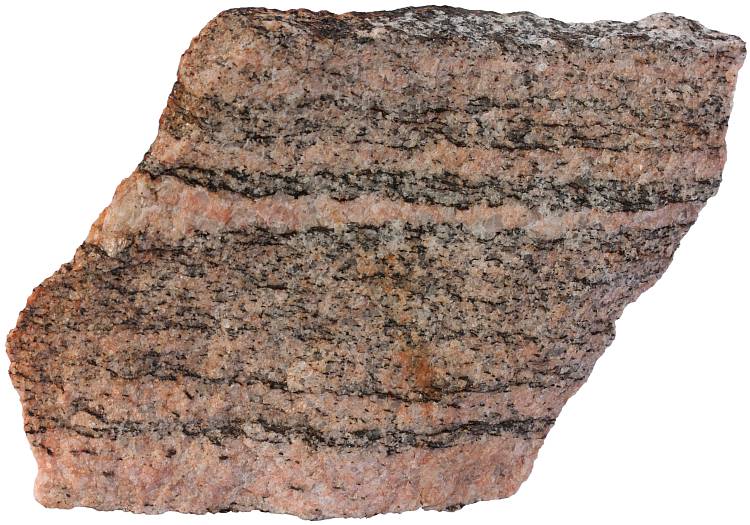There are three basic types of rock:
Sedimentary
- Formed from sediments (definition 2), may be eroded fragments of other types of rocks, from dead remains of animals, or from solutions on earth that form solids via chemical reaction (these are called precipitates).
- They can be deposited (through a process called deposition...see below) on both land and in aquatic environments.
- Most common is limestone (Calcium Carbonate - CaCO3), formed in marine environments and is a source of many fossils.
- Sediment accumulates of thousands of years...and can be hundreds of meters thick.
- The pressure of this rock on top of rock is so immense that the sediments fuse together, in a process called cementation.
- Cementation can result in sedimentary rocks such as sandstone and limestone.
- Examples of sedimentary rocks include: conglomerate, breccia, shale, halite, gypsum, coal, and more. Find out what these look like and more information on each by looking here.
Limestone
Igneous
- Formed when magma (molten rock) cools and solidifies.
- Quick side note...magma is within a volcano or in the mantle, lava is when that molten rock comes out of the volcano...same stuff, different location
- Usually forms beneath the land's surface, called intrusive igneous rock
- intrusive igneous rock cools slowly, since it is below the surface, and forms large crystals
- examples include: diorite, gabbro, granite and pegmatite
- Some molten rock makes it to the surface and cools rapidly, called extrusive igneous rock
- extrusive igneous rock will have smaller crystals due to the rapid cooling
- examples include: andesite, basalt, obsidian, pumice, rhyolite and scoria
- Pictures and information from both types of igneous rock can be found here.
Granite
- Formed when igneous or sedimentary rock is under extreme heat and pressure
- Can happen at plate boundaries (pressure) or when in contact with magma (heat)
- Some metamorphic rock forms in layers...this is known as foliated metamorphic rock.
- An example is gneiss...which is formed from igneous granite. It sure is gneiss!
- Other metamorphic rock has no apparent ordered structure...this is known an non-foliated metamorphic rock
- An example is marble...which is formed from sedimentary limestone. Wow, this stuff rocks!
- See examples of metamorphic rocks here.
Gneiss
Now that you know the different types of rock, you may be able to put together this whole concept of a "rock cycle." Before we look at the "big picture," there are three primary processes that happen within it need to be familiar with:
- Denudation - This is the process by which rocks are weathered and eroded.
- Weathering - the breakdown of rocks in situ (they stay in place during the breakdown)
- Chemical Weathering - chemical change of rocks reacting with air or water
- Mechanical Weathering - breaking up of rocks...not altering chemistry
- Biological Weathering - result of plant or animal activity (ex. roots shattering rock)
- Erosion - the breakdown of rocks involving movement of the pieces following
- Movement due to wind, waves, streams, rivers, or glaciers.
- Transportation - The processes that carry sediment or other materials away from their point of origin. Transporting media include wind, water and mantle convection currents. Does not break down the rock itself (erosion)
- Deposition - When materials/rocks settle out from whatever is transporting them
FINALLY...let's take a look at the rock cycle...to do this you are going to click the link below to go to a Prezi presentation. Prezis are really cool...all you have to do is click the arrows and follow along...it will guide you through the cycle!
That was a pretty good, basic understanding of how it works...but it's not limited to just those directions alone...almost all of it can change to the other forms directly as shown by this graphic.




No comments:
Post a Comment